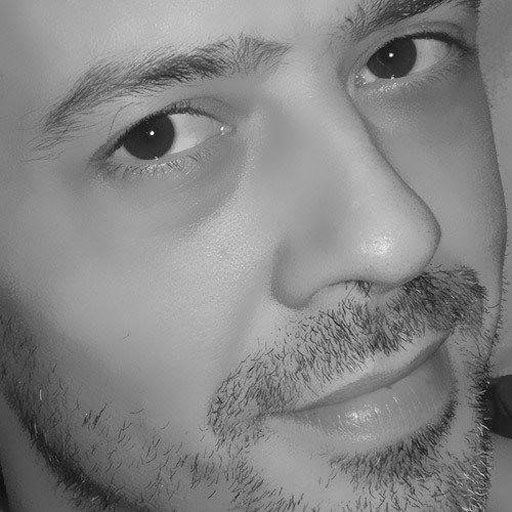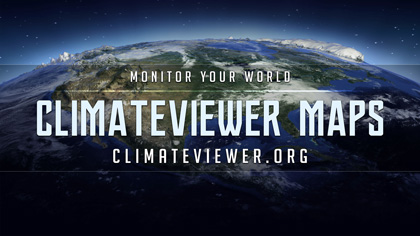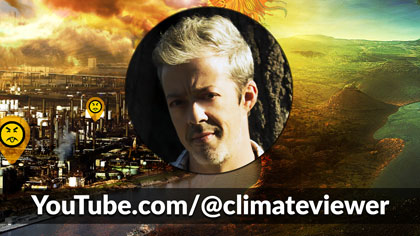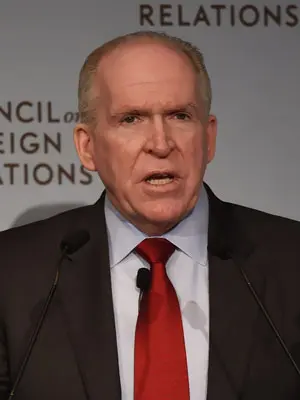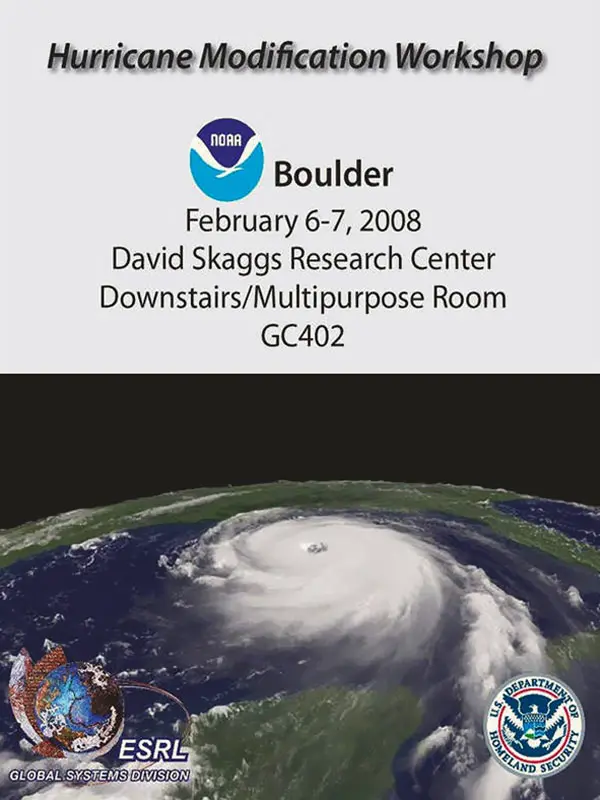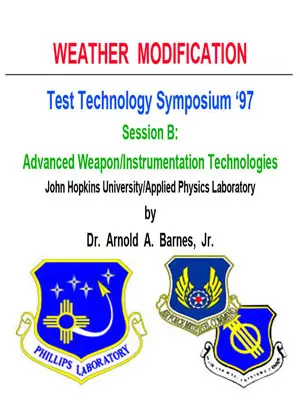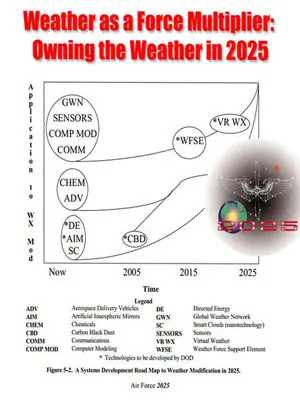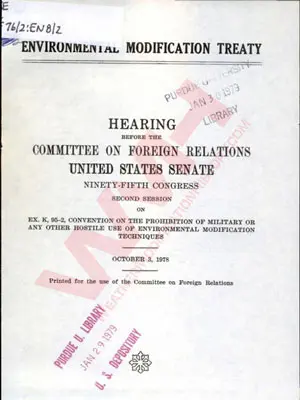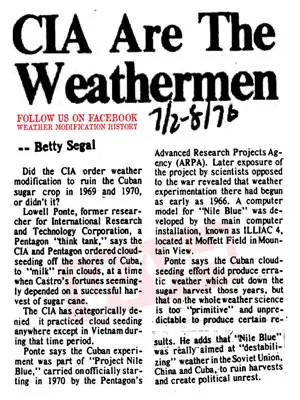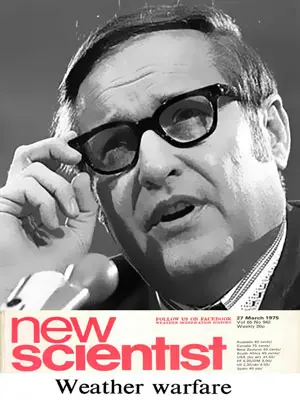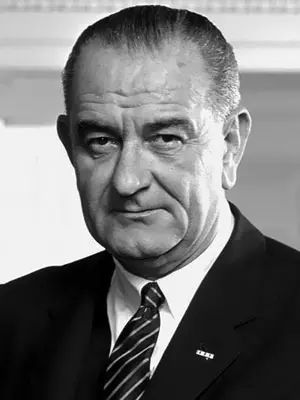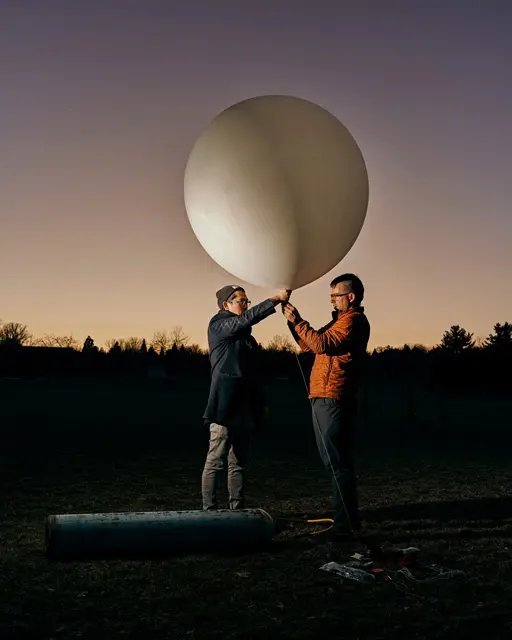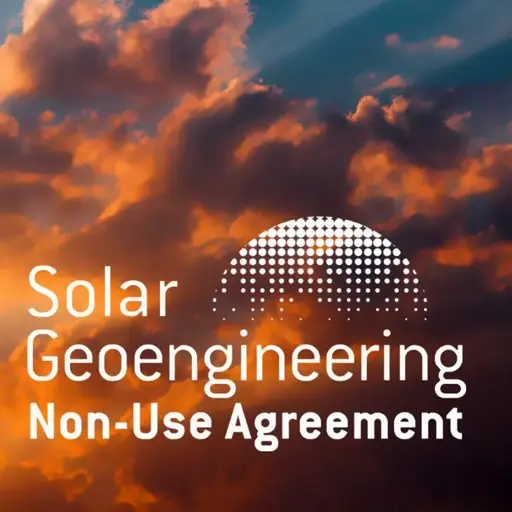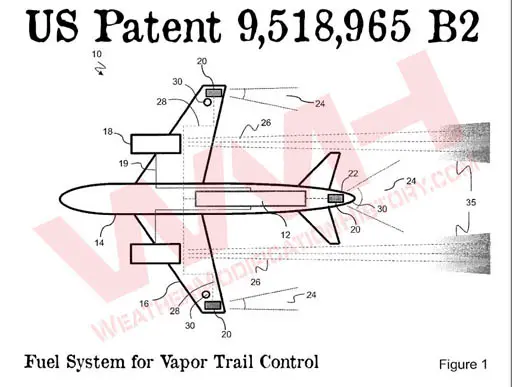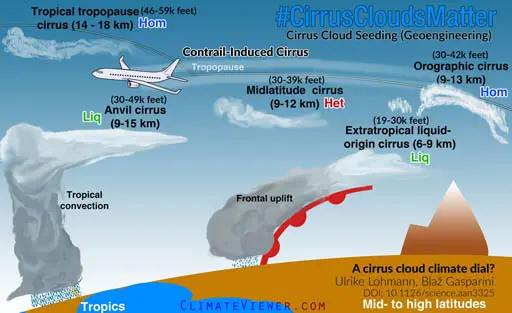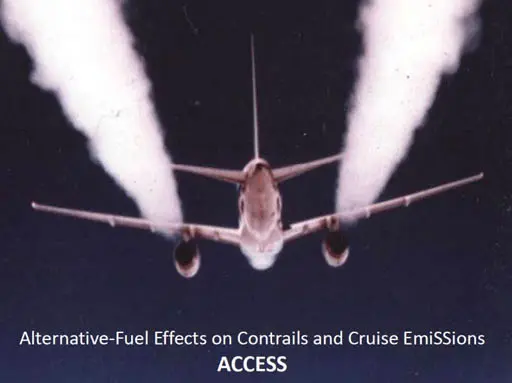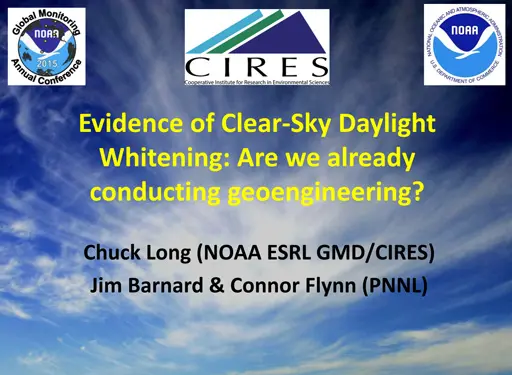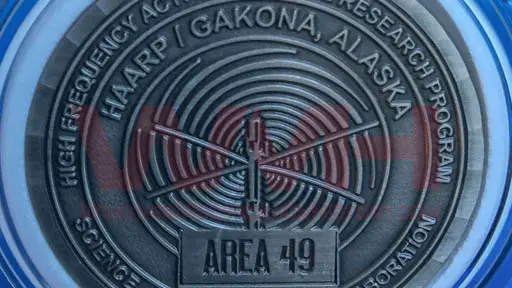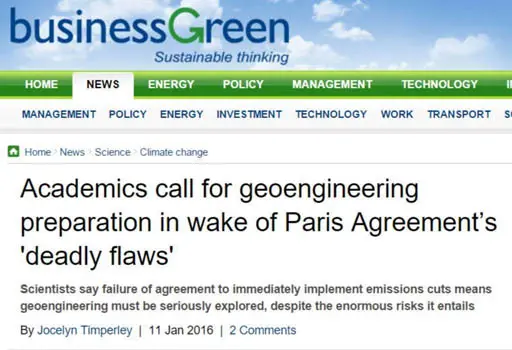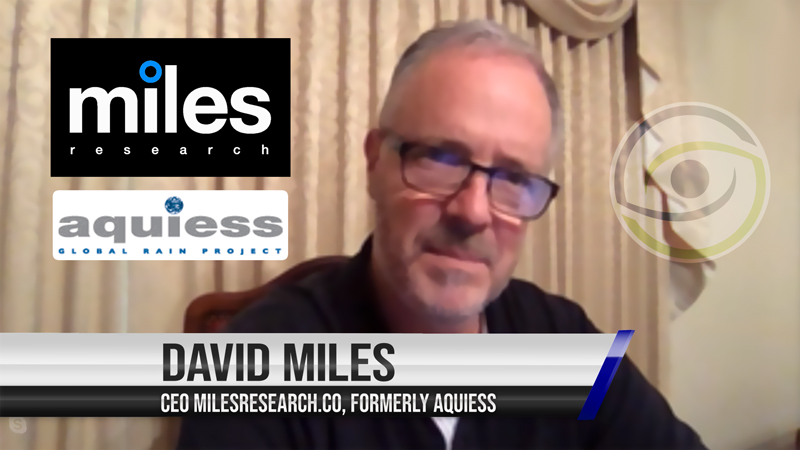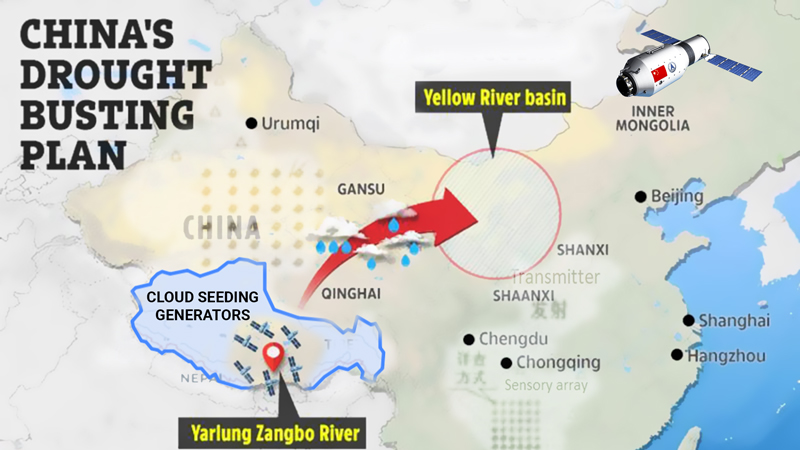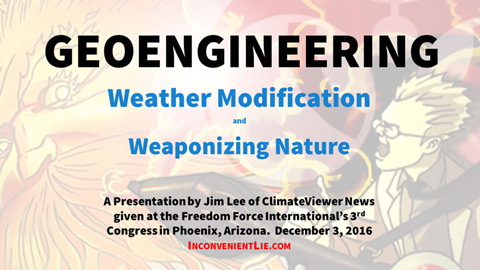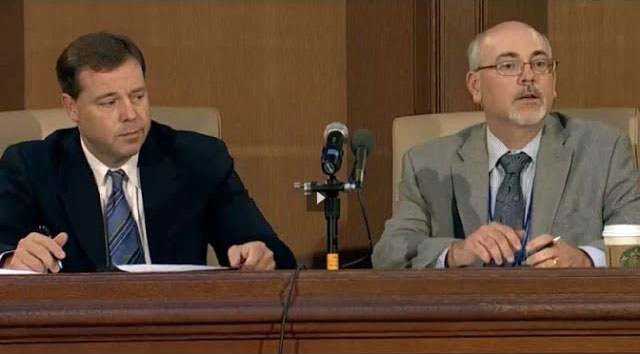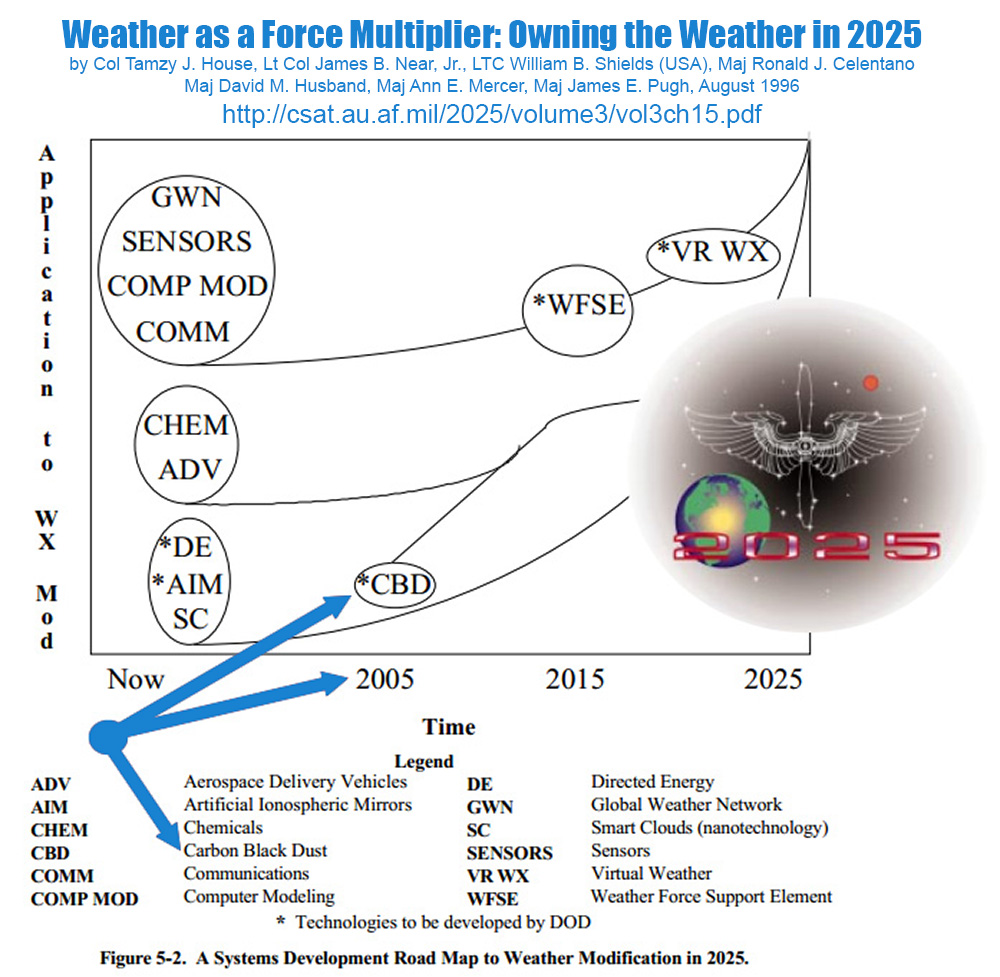
1994 FOIAs Reveal Military Weather Modification Plans
- USAF FOIA - Weather Modification: USAF Phillips Laboratory (AFMC) Geophysics Directorate mirrored on Scribd
- US Navy FOIA - Weather Modification: Non-Lethal Warfare Proposal 1994 mirrored on Scribd
- FOIA source: DELETED: www.sunshine-project.org/enmod
This article is part of the series: HAARP and the Sky Heaters Also check out Weather Modification History
Following the 1995 USAF brainstorming session, "Owning the Weather in 2025", dreams of weather warfare become reality. Dr. Arnold Barnes explains the US militaries' current weather modification capabilities and future intentions. This presentation was removed from the internet and recovered from archive.org by Jim Lee of ClimateViewer.com
TEST TECHNOLOGY SYMPOSIUM '97
"THE ARMY AFTER NEXT, HOW WILL WE TEST?"
WEATHER MODIFICATION
Dr. Arnold Barnes Phillips Lab/GPO
Hanscom Air Force Base, MA
Abstract - Compressed Power Point File (729 Kb)
"The difficulty, cost, and risk of developing a weather control system for military applications are extremely high. However, the potential benefits for national security could be even higher. Enemy weather modification weapons are possibilities which, like it or not, may be possible and must be considered," Spacecast 2020. This paper considers such concepts as hole boring for surveillance; the use of space mirrors for night battlefield illumination, modifying the environment, enforcement of curfews and similar civil control measures; use of carbon black to retarget precipitation; fog dissipation; and cirrus enhancement.
Table of Contents
- Weather Modification
- Potential Weather Modification Capabilities AF 2025
- Treaty Issues
- Potential Weather Modification Capabilities AF 2025
- Solar Activity
- HAARP
- Potential Weather Modification Capabilities AF 2025
- History of Air Force Weather Modification
- Cloud Seeding
- Cloud Seeding (cont.)
- Strategy for Re-evaluation of Cloud and Fog Modification
- Modeling and Simulation
- Cloud Cover Over the Earth
- Chances IR Database 23 Apr 1994, 2000 UTC
- Chances C/NC Product 23 Apr 1994, 2000 UTC
- Cloud Impacts on DoD Operations and Systems
- Potential Weather Modification Capabilities AF 2025
- Storm Modification
- Improvements in Weather Forecasts
- New Weapon Systems More Sensitive to the Atmosphere
- Summary

WEATHER MODIFICATION
Test Technology Symposium '97
Session B:
Advanced Weapon/Instrumentation Technologies
John Hopkins University/Applied Physics Laboratory
by Dr. Arnold A. Barnes, Jr.
Senior Scientist
Optical Effects Division
Phillips Laboratory
19 March 1997
Notes: For more information on the basic and applied research being conducted by the former Atmospheric Sciences Division (recently integrated into the Optical Effects Division) and its contractors look on the Internet at the Home Page for the Geophysics Directorate found at http://www.plh.af.mil under which you will find the ATMOSPHERIC SCIENCES DIVISION.
The telephone number for the Optical Effects Division office is (617) 377-2952 or DSN 478-2952.
Dr. Barnes may be reached at (617) 377-2939 or DSN 478-2939. His FAX number is (617) 377-8892 or DSN 478-8892 and his E-mail address is: barnes@plh.af.mil
SLIDE 2
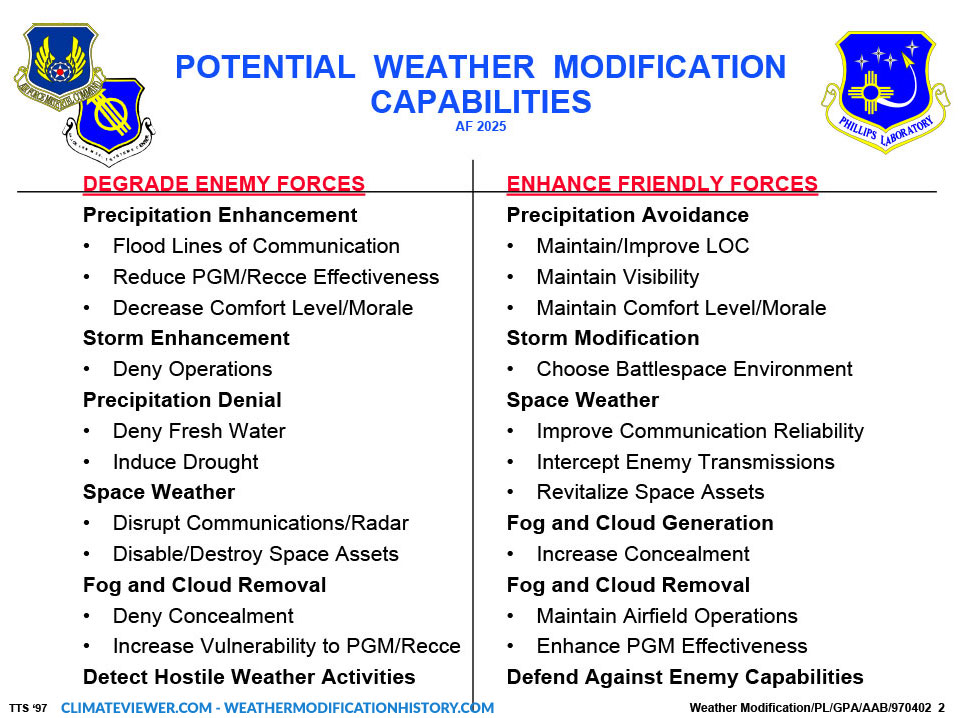
DEGRADE ENEMY FORCES
Precipitation Enhancement
- Flood Lines of Communication
- Reduce PGM/Recce Effectiveness
- Decrease Comfort Level/Morale
Storm Enhancement
- Deny Operations
Precipitation Denial
- Deny Fresh Water
- Induce Drought
Space Weather
- Disrupt Communications/Radar
- Disable/Destroy Space Assets
Fog and Cloud Removal
- Deny Concealment
- Increase Vulnerability to PGM/Recce
Detect Hostile Weather Activities
Precipitation Avoidance
- Maintain/Improve LOC
- Maintain Visibility
- Maintain Comfort Level/Morale
Storm Modification
- Choose Battlespace Environment
Space Weather
- Improve Communication Reliability
- Intercept Enemy Transmissions
- Revitalize Space Assets
Fog and Cloud Generation
- Increase Concealment
Fog and Cloud Removal
- Maintain Airfield Operations
- Enhance PGM Effectiveness
Defend Against Enemy Capabilities
Notes: “From enhancing friendly operations or disrupting those of the enemy via small-scale tailoring of natural weather patterns to complete dominance of global communications and counterspace control, weather-modification offers the war fighter a wide-range of possible options to defeat or coerce an adversary. Some of the potential capabilities a weather-modification system could provide to a war-fighting commander in chief (CINC) are listed” above.
“Technology advancements in five major areas are necessary for an integrated weather-modification capability: (1) advanced nonlinear modeling techniques, (2) computational capability, (3) information gathering and transmission, (4) a global sensor array, and (5) weather intervention techniques. Some intervention tools exist today and others may be developed and refined in the future.”
SLIDE 3
 Treaty Issues
Treaty Issues
- The U. N. Convention on the Prohibition of Military or any other Hostile Use of Environmental Modification, which went into effect 5 October 1978, applies only to “widespread, long-lasting or severe” environmental modifications.
- Local, non-permanent changes, such as precipitation enhancement, hail suppression
- Since 1978 the official Air Force position has been that weather modification had little utility or military payoff as a weapon of war. - The official Air Force position needs to be reevaluated:
- In the light of 19 years of scientific advances
- In the light of advanced weapon systems which are more environmentally sensitive
- To prepare against technological surprise
“Atmospheric scientists have pursued terrestrial weather modification in earnest since the 1940s, but have made little progress because of scientific, legal, and social concerns, as well as certain controls at various government levels. Using environmental modification techniques to destroy, damage, or injure another state are prohibited. However, space presents us with a new arena, technology provides new opportunities, and our conception of future capabilities compels a reexamination of this sensitive and potentially risky topic.”
“The difficulty, cost, and risk of developing a weather control system for military applications are extremely high. However, the potential benefits for national security."
SPACECAST 2020 has been updated by AF 2025 which can be found on the internet at:
http://csat.au.af.mil/2025/volume3/vol3ch15.pdf
SLIDE 4

DEGRADE ENEMY FORCES
Precipitation Enhancement
- Flood Lines of Communication
- Reduce PGM/Recce Effectiveness
- Decrease Comfort Level/Morale
Storm Enhancement
- Deny Operations
Precipitation Denial
- Deny Fresh Water
- Induce Drought
Space Weather
- Disrupt Communications/Radar
- Disable/Destroy Space Assets
Fog and Cloud Removal
- Deny Concealment
- Increase Vulnerability to PGM/Recce
Detect Hostile Weather Activities
Precipitation Avoidance
- Maintain/Improve LOC
- Maintain Visibility
- Maintain Comfort Level/Morale
Storm Modification
- Choose Battlespace Environment
Space Weather
- Improve Communication Reliability
- Intercept Enemy Transmissions
- Revitalize Space Assets
Fog and Cloud Generation
- Increase Concealment
Fog and Cloud Removal
- Maintain Airfield Operations
- Enhance PGM Effectiveness
Defend Against Enemy Capabilities
Notes:
From DEFENSE NEWS March 10-16, 1997
U.S. Army War Game Reveals Satellite Vulnerability
Opening Salvo Knocks out Most Space Capabilities
“A recent Army war game set in 2020 revealed the U.S. military’s increasing reliance on satellite-based information dominance may prove as much a liability as an asset in a real conflict.
During the war game, the team playing Russia launched devastating strikes against U.S. satellites. The strike culminated in a nuclear attack that destroyed virtually every satellite orbiting Earth, sending the world “back to about 1950 in terms of technology,” one participant said.”
- The next two pages describe (1) a natural phenomena which will impact space operations and communications every eleven years, and (2) a man made modification of the ionosphere which has the potential of extending over-the-horizon surveillance and improving communications to the warfighter.
- The Air Force Geophysics Directorate is heavily involved in both of these areas, both from the research aspects and from the impact and application to Air Force and DoD weapons systems.
SLIDE 5

SOLAR ACTIVITY
Next Maximum: Jan 1999 Mar 2000 Jun 2001
Notes: Solar Cycle 23 Project
The panel examined 28 forecasts, grouped into 6 basic approaches. Four of the 6 were in general agreement. The greatest weight was given to the “precursor” techniques which have physical basis and were successful in predicting the last 2 cycles. While this forecast is for a large cycle, the panel did not find direct evidence that the next cycle will exceed historical record levels, and therefore estimate that the likelihood that Cycle 23 will exceed Cycle 19 is low. In advance of a confirmation date for Cycle 22/23 minimum, the range in date of maximum is as follows:
- January 1999
- March 2000
- June 2001
SLIDE 6

Notes: HAARP is a scientific endeavor aimed at studying the properties and behavior of the ionosphere, with particular emphasis on being able to understand and use it to enhance communications and surveillance systems (e.g., over-the-horizon) for both civilian and defense purposes. In addition, diagnostics installed at the HAARP facility will be useful for a variety of other research purposes including the study of global warming and ozone depletion. HAARP is managed jointly by:
- Mr. John Heckscher, Phillips Laboratory/GPS, 29 Randolph Rd., Hanscom AFB, MA 01731-3010
- Dr. Richard Brandt, Office of Naval Research, 800 North Quincy Street, Arlington, VA 22217.
http://server5550.itd.nrl.navy.mil/haarp.html https://climateviewer.com/space-weather-modification/
SLIDE 7
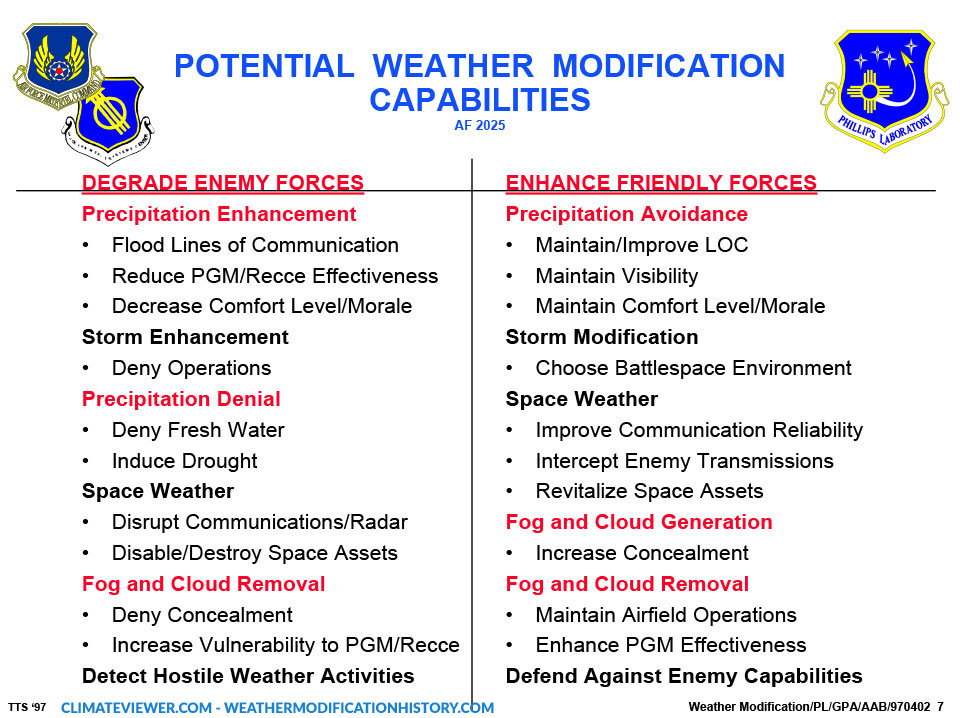
DEGRADE ENEMY FORCES
Precipitation Enhancement
- Flood Lines of Communication
- Reduce PGM/Recce Effectiveness
- Decrease Comfort Level/Morale
Storm Enhancement
- Deny Operations
Precipitation Denial
- Deny Fresh Water
- Induce Drought
Space Weather
- Disrupt Communications/Radar
- Disable/Destroy Space Assets
Fog and Cloud Removal
- Deny Concealment
- Increase Vulnerability to PGM/Recce
Detect Hostile Weather Activities
Precipitation Avoidance
- Maintain/Improve LOC
- Maintain Visibility
- Maintain Comfort Level/Morale
Storm Modification
- Choose Battlespace Environment
Space Weather
- Improve Communication Reliability
- Intercept Enemy Transmissions
- Revitalize Space Assets
Fog and Cloud Generation
- Increase Concealment
Fog and Cloud Removal
- Maintain Airfield Operations
- Enhance PGM Effectiveness
Defend Against Enemy Capabilities
Notes: The next section concerns the enhancement or retardation of precipitation (rain or snow), the generation or removal of cirrus clouds or contrails, and the removal of fog.
SLIDE 8

HISTORY OF AIR FORCE WEATHER MODIFICATION
- PREVIOUS WEATHER MODIFICATION WORK BY THIS LABORATORY'S PREDECESSORS
- FIDO; WW II
- Clearing of Supercooled Fog at Airfields in Alaska and other cold regions; 50s and 60s
- Hole Clearing with Carbon Black; 50s and 60s
- Hole Clearing with Silver Iodide, etc.; 50s through 70s
- Hole Clearing by Helicopter; 60s and 70s
- Ho Chi Minh Trail Muddying; 60s and 70s
- Contrail Suppression; 70s
Notes: - FIDO: The technique of using fires or heaters placed along side runways to dissipate the fog and/or low stratus was used in England during WW II. The techniques were improved by this lab and others, and an application of the lab's work for use at a major airport in the US was cancelled by the AF during the drawdown in the mid 70s.
- Supercooled Fog Clearing: This technique was developed and improved by this lab, was used successfully
- Hole Clearing with Carbon Black: Research conducted at Hanscom Field, Massachusetts blackened the inside of our C-47 before the dispersal technique was perfected
- Hole Clearing by Silver Iodide, Dry Ice and Urea: We showed that cloud holes could be targeted to open over desired airfields. AFCRL-TR-78-0193.
- Hole Clearing by Helicopter: Research conducted at Lewisburg, West Virginia showed that the size of the hole was directly related to the weight
- Ho Chi Minh Trail Muddying: Project POPEYE was conducted from Udorn, Thailand from 1967 to 1972 to create rain over parts of the Ho Chi Minh Trail during the rainy southwest monsoon seasons.
SLIDE 9
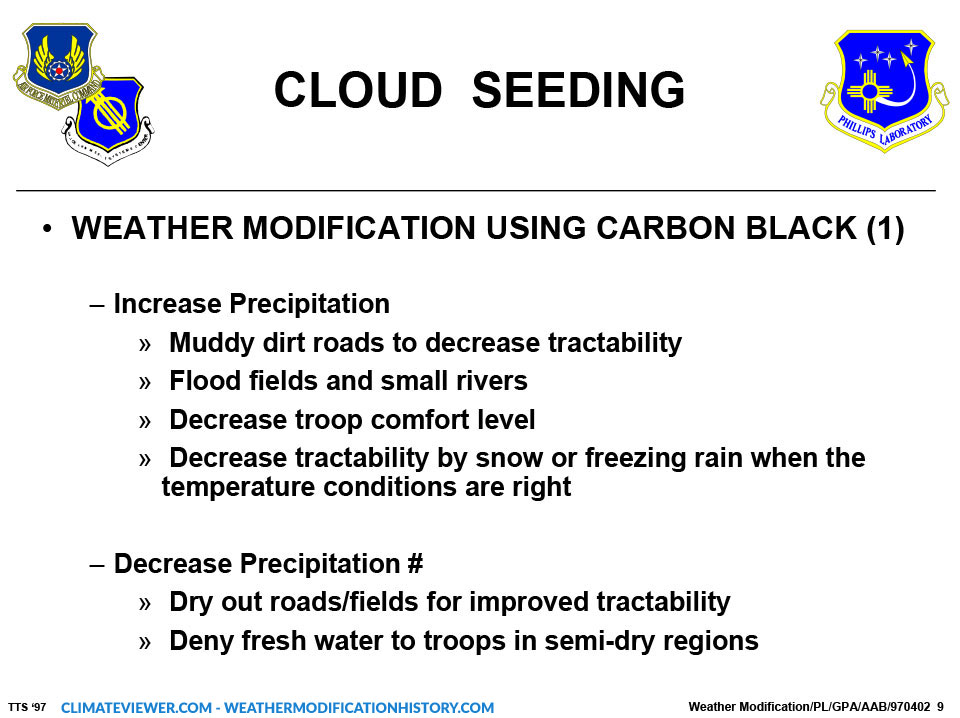
CLOUD SEEDING
WEATHER MODIFICATION USING CARBON BLACK (1)- Increase Precipitation
- Muddy dirt roads to decrease tractability
- Flood fields and small rivers
- Decrease troop comfort level
- Decrease tractability by snow or freezing rain when the temperature conditions are right
- Decrease Precipitation #
- Dry out roads/fields for improved tractability
- Deny fresh water to troops in semi-dry regions
Notes: The following is an example of the use of one particular seeding agent* to modify the weather. This information was provided to the Office of the Under Secretary of Defense (A&T) on a request for ideas for Non-Lethal Technologies and Weapons which “avoided or minimized the loss of life and associated damage.”
In the paper “Weather Modification by Carbon Dust Absorption of Solar Energy” Gray et al (Journal of Applied Meteorology, Vol. 15, April 1976, 355-386) showed that observational and modeling information indicated that the solar heating of carbon dust could be deployed on the theater scale (~100-300 km) to achieve precipitation enhancement, to create cirrus clouds, and to dissipate fog and low clouds.
Risks and Limitations:
- Creation of optimum submicron particles LOW
- Achieve and maintain desired horizontal distribution of carbon black MEDIUM
- Opportunities to capitalize on investment militarily MEDIUM/HIGH
- Political implications / health hazards MEDIUM/LOW
- * Other biodegradable seeding agents, such as silver iodide and urea, have shown some successes, but more research is needed to find (or develop) optimum seeding agents and to forecast suitable situations.
- # This may be accomplished by enhancing precipitation in other nearby areas.
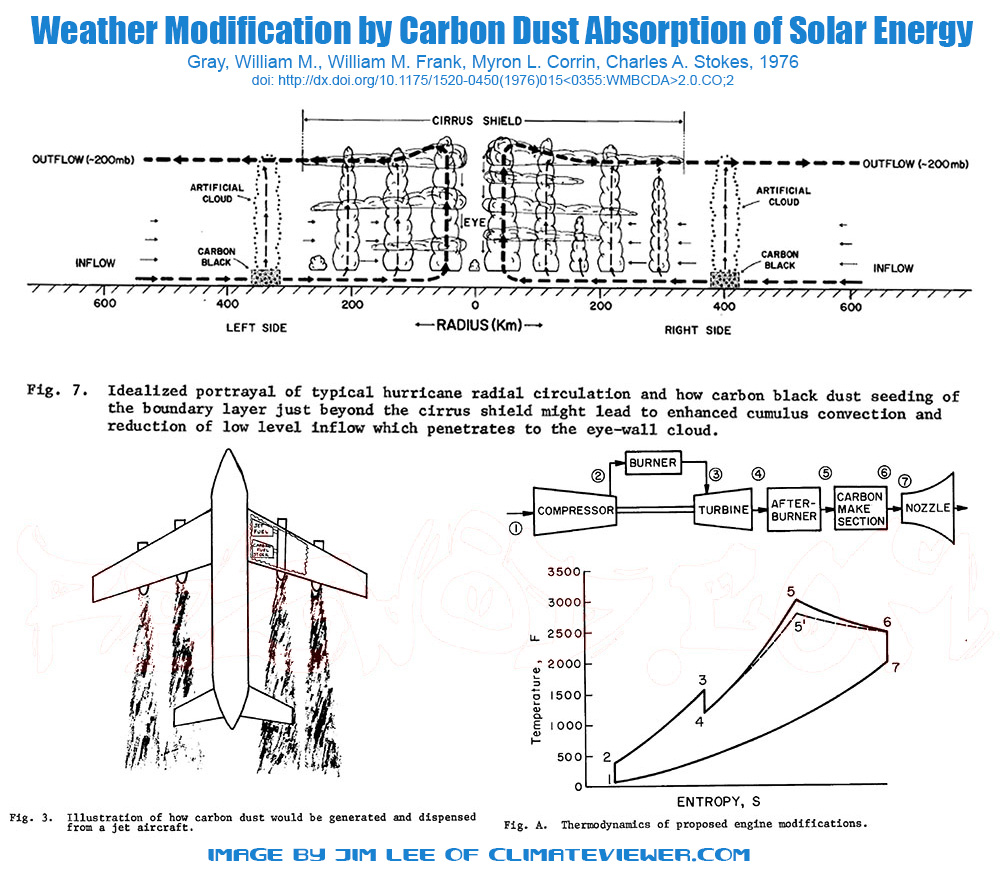
William M. Gray, , William M. Frank, , Myron L. Corrin, and , and Charles A. Stokes
Atmospheric Science Department, Colorado State University, Ft. Collins 80523
SLIDE 10

CLOUD SEEDING (cont.)
WEATHER MODIFICATION USING CARBON BLACK (2)
- Increase Cirrus Cloud Cover
- Deny visual satellite or high altitude reconnaissance
- Decrease light level for night time operations - Dissipate Fog
- Uncover targets for visual raids
- Provide visual inspection of damage
- Provide visual reconnaissance
- Open airfields for landing / recovery
• Numerical model studies completed 1997
• Engineering design of test engine model 1998
• Ground-based field trials completed 2000
• Airborne T&E of prototype completed 2002
• Engineering design for airborne carbon black delivery system completed 2004
FY 6.1 6.2 6.3 TOTAL
96 $1.0M $1.0M
97 $1.0M $1.0M
98 $1.0M $1.5M $2.5M
99 $1.0M $1.5M $2.5M
00 $1.5M $2.0M $3.5M
01 $1.5M $2.0M $3.5M
02 $1.5M $2.0M $3,5M
03 $2.0M $2.0M
04 $2.0M $2.0M
05 $2.0M $2.0M
Rough estimate of total cost to operational capability: $23.5M. Life cycle costs have not been estimated.
Build upon (1) NOAA’s “Atmospheric Modification Program” (AMP), a joint NOAA/States effort written into NOAA’s budget every year by Congress, (2) the Illinois State Water Survey studies of inadvertent weather modification, and (3) articles in the Journal of Weather Modification.
SLIDE 11

STRATEGY FOR RE-EVALUATION OF CLOUD AND FOG MODIFICATION
- PHYSICS AND CHEMISTRY OF NUCLEATION
- CLOUD PHYSICS AND RADIATION
- COMPUTERS AND NUMERICAL WEATHER PREDICTION (NWP) MODELS
- Notes: Over the years there have been small university groups looking at the physics and chemistry of nucleation including the processes of phase change of water in the atmosphere. Advances in these fields have not been very actively coordinated. One should employ recent technology to search for, or develop, optimum seeding agents to dissipate clouds; to extend the lifetime, extent and optical thickness of clouds; and to retarget areas of precipitation.
- Research in the field of cloud physics and radiative interactions is beginning to pickup because of (1) Climate Change investigations of global warming, (2) an AF desire to suppress
SLIDE 12

MODELING AND SIMULATION
- WARNING - MUST TEST AGAINST REAL DATA
- NUCLEAR WINTER vs NUCLEAR SUMMER
- US SUPERSONIC TRANSPORT AND OZONE - WEATHER FORECASTS GET TIMELY FEEDBACK
- NWP BASIC EQUATIONS CORRECTED EMPIRICAL
SLIDE 13
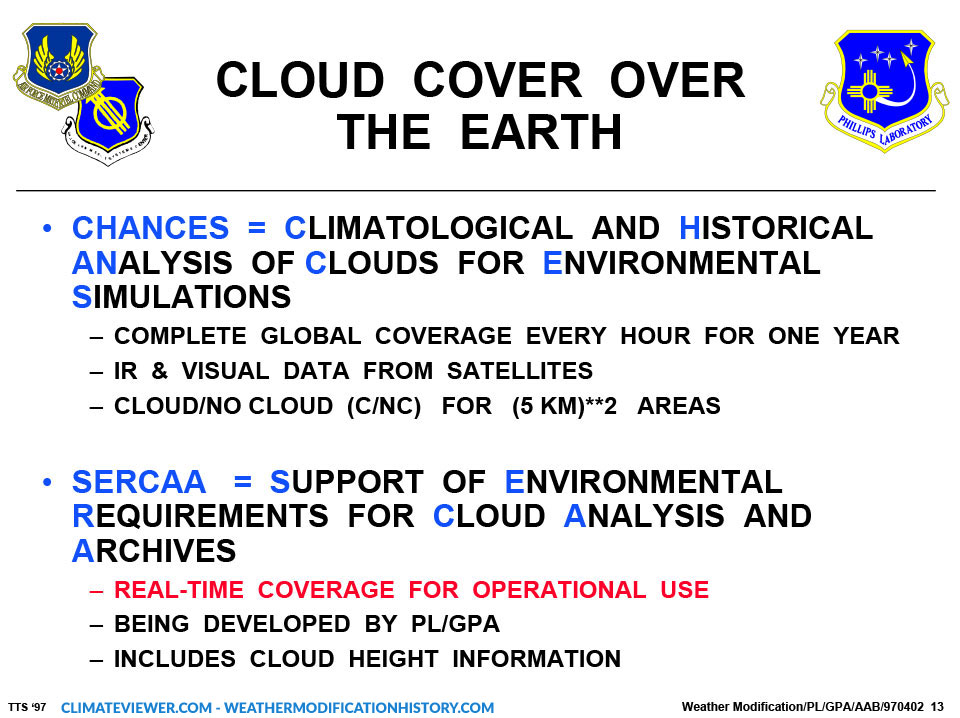
CLOUD COVER OVER THE EARTH
- CHANCES = CLIMATOLOGICAL AND HISTORICAL ANALYSIS OF CLOUDS FOR ENVIRONMENTAL SIMULATIONS
- COMPLETE GLOBAL COVERAGE EVERY HOUR FOR ONE YEAR
- IR & VISUAL DATA FROM SATELLITES
- CLOUD/NO CLOUD (C/NC) FOR (5 KM)**2 AREAS - SERCAA = SUPPORT OF ENVIRONMENTAL REQUIREMENTS FOR CLOUD ANALYSIS AND ARCHIVES
- REAL-TIME COVERAGE FOR OPERATIONAL USE
- BEING DEVELOPED BY PL/GPA
- INCLUDES CLOUD HEIGHT INFORMATION
Cloud height information is used in the planning of the height and type of surveillance missions or of weapons delivery missions.
SLIDE 14
 CHANCES IR DATABASE 23 APR 1994, 2000 UTC
Notes: This is an example of the CHANCES IR database for the one hour centered on 2000 UTC. The data were obtained from eight satellites using both the visible and IR. Lower clouds are darker gray, hence the difference between this and the following viewgraph. In order to fill in missing areas, data from the nearest hour, forward or backward, were used. Note the inter-tropical convergence zone and the frontal zone across Florida and out into the Atlantic.
CHANCES IR DATABASE 23 APR 1994, 2000 UTC
Notes: This is an example of the CHANCES IR database for the one hour centered on 2000 UTC. The data were obtained from eight satellites using both the visible and IR. Lower clouds are darker gray, hence the difference between this and the following viewgraph. In order to fill in missing areas, data from the nearest hour, forward or backward, were used. Note the inter-tropical convergence zone and the frontal zone across Florida and out into the Atlantic.
SLIDE 15
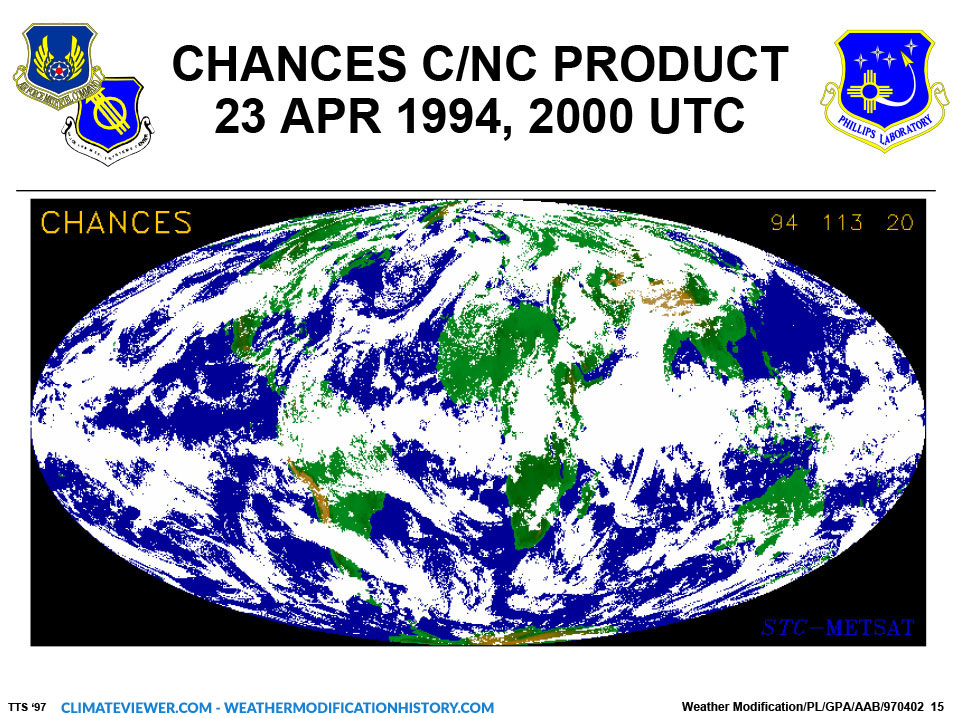 CHANCES C/NC PRODUCT 23 APR 1994, 2000 UTC
Notes: In this example of CHANCES data the oceans are blue, the land masses are green or brown, and the clouds are overlaid in white. Each area (approximately 5 km X 5 km) is determined to be either Cloudy or clear (NoCloud), hence the C/NC designation. Since this is an equal area projection, it clearly shows the extent (approximately 70%) of clouds over the whole earth. In summary, clouds are important when doing satellite surveillance or reconnaissance in the visible or IR.
CHANCES C/NC PRODUCT 23 APR 1994, 2000 UTC
Notes: In this example of CHANCES data the oceans are blue, the land masses are green or brown, and the clouds are overlaid in white. Each area (approximately 5 km X 5 km) is determined to be either Cloudy or clear (NoCloud), hence the C/NC designation. Since this is an equal area projection, it clearly shows the extent (approximately 70%) of clouds over the whole earth. In summary, clouds are important when doing satellite surveillance or reconnaissance in the visible or IR.
SLIDE 16
 CLOUD IMPACTS ON DOD OPERATIONS AND SYSTEMS
CLOUD IMPACTS ON DOD OPERATIONS AND SYSTEMS
- WW II - Aborted Missions, FIDO
- VIETNAM - Operation POPEYE
- GULF WAR - Aborted Missions
- CIDOS - CONFERENCES EVERY 18 MONTHS
23-25 September 1997, Naval Warfare Center, RI
POC: Donald Chisholm, PL/GPA, 617-377-2975.
SLIDE 17

DEGRADE ENEMY FORCES
Precipitation Enhancement
- Flood Lines of Communication
- Reduce PGM/Recce Effectiveness
- Decrease Comfort Level/Morale
Storm Enhancement
- Deny Operations
Precipitation Denial
- Deny Fresh Water
- Induce Drought
Space Weather
- Disrupt Communications/Radar
- Disable/Destroy Space Assets
Fog and Cloud Removal
- Deny Concealment
- Increase Vulnerability to PGM/Recce
Detect Hostile Weather Activities
Precipitation Avoidance
- Maintain/Improve LOC
- Maintain Visibility
- Maintain Comfort Level/Morale
Storm Modification
- Choose Battlespace Environment
Space Weather
- Improve Communication Reliability
- Intercept Enemy Transmissions
- Revitalize Space Assets
Fog and Cloud Generation
- Increase Concealment
Fog and Cloud Removal
- Maintain Airfield Operations
- Enhance PGM Effectiveness
Defend Against Enemy Capabilities
Notes: In the previous section it has been shown that small scale changes in the weather can be made. In addition to retargeting precipitation; opening holes in fog and low stratus to facilitate landing, recovery or surveillance; local modification of cirrus clouds and contrails; hail suppression and frost prevention are used in some countries to protect crops from damage. The next page looks at the energy of major storm systems such as hurricanes and the major low pressure systems which we see on daily weather maps crossing the United States. The energy in these storms is orders of magnitude larger than that which is readily available to mankind for modifying these storms. At the present time, the only hope that we see of modifying these storms (and this is a long shot) would be to improve temporal and spatial weather forecasts to the point where we could forecast the “butterfly” effects.
SLIDE 18
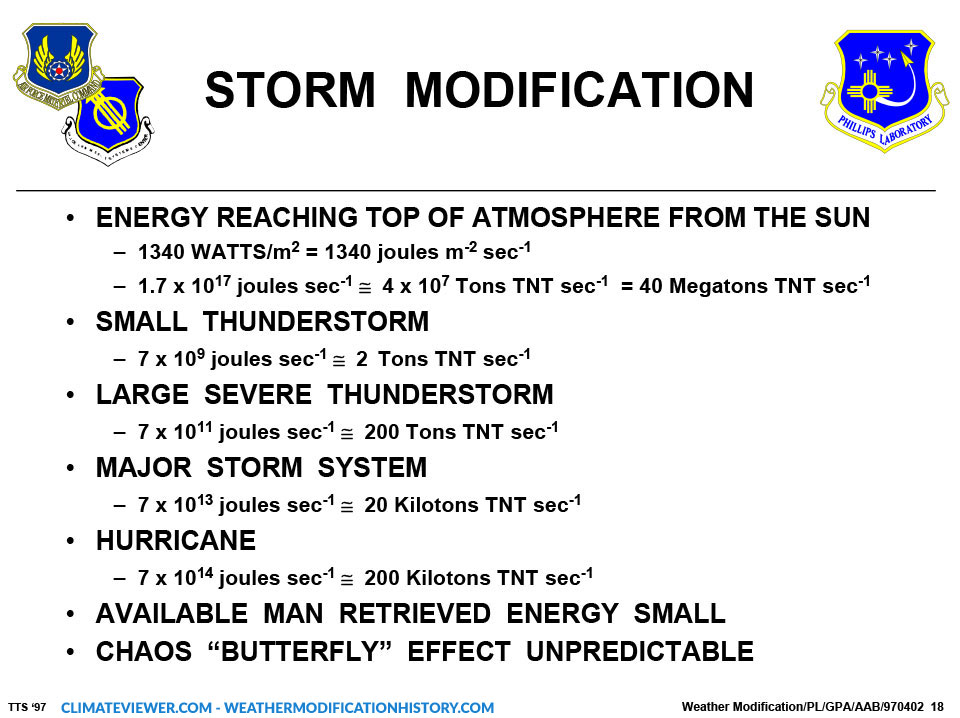
STORM MODIFICATION
- ENERGY REACHING TOP OF ATMOSPHERE FROM THE SUN
1340 WATTS/m2 = 1340 joules m-2 sec-1
1.7 x 1017 joules sec-1 @ 4 x 107 Tons TNT sec-1 = 40 Megatons TNT sec-1 - SMALL THUNDERSTORM
7 x 109 joules sec-1 @ 2 Tons TNT sec-1 - LARGE SEVERE THUNDERSTORM
7 x 1011 joules sec-1 @ 200 Tons TNT sec-1 - MAJOR STORM SYSTEM
7 x 1013 joules sec-1 @ 20 Kilotons TNT sec-1 - HURRICANE
7 x 1014 joules sec-1 @ 200 Kilotons TNT sec-1 - AVAILABLE MAN RETRIEVED ENERGY SMALL
- CHAOS “BUTTERFLY” EFFECT UNPREDICTABLE
SLIDE 19

IMPROVEMENTS IN WEATHER FORECASTS
- SATELLITE WITH 26 IR CHANNELS
2004 PROJECTED LAUNCH
WILL PROVIDE WORLD WIDE VERTICAL TEMPERATURE PROFILES BY 2020 - CHAOS SEEMS TO BE LIMITED TO ACTIVE REGIONS
LOOK FOR THE “BUTTERFLY” - LIMITS OF FORECASTS
1950 3 DAYS
1997 7 DAYS
2040 14 DAYS - MAJOR IMPROVEMENTS IN CLOUD FORECASTS BY 2010
Clouds and water vapor seem to be the key to further progress. New satellite data should provide improved 3 dimensional, global coverage of these parameters. Improvements in the forecasts will be heavily dependent on advances in distributed processing and other computer technologies.
SLIDE 20

NEW WEAPON SYSTEMS MORE SENSITIVE TO THE ATMOSPHERE
- COMPOSITE MATERIALS AND LIGHTNING
- ELECTRONIC COMPONENTS AND LIGHTNING
- NEED TO INVOLVE WEATHER OFFICERS VERY EARLY
WW II RADAR EXAMPLE - THE ATMOSPHERE CAN HELP AS WELL AS HINDER
CLOUDS AND THE AIRBORNE LASER
LASER LIGHTNING ROD TO TRIGGER LIGHTNING
LASER FOG CLEARING AND HOLE BORING
SLIDE 21
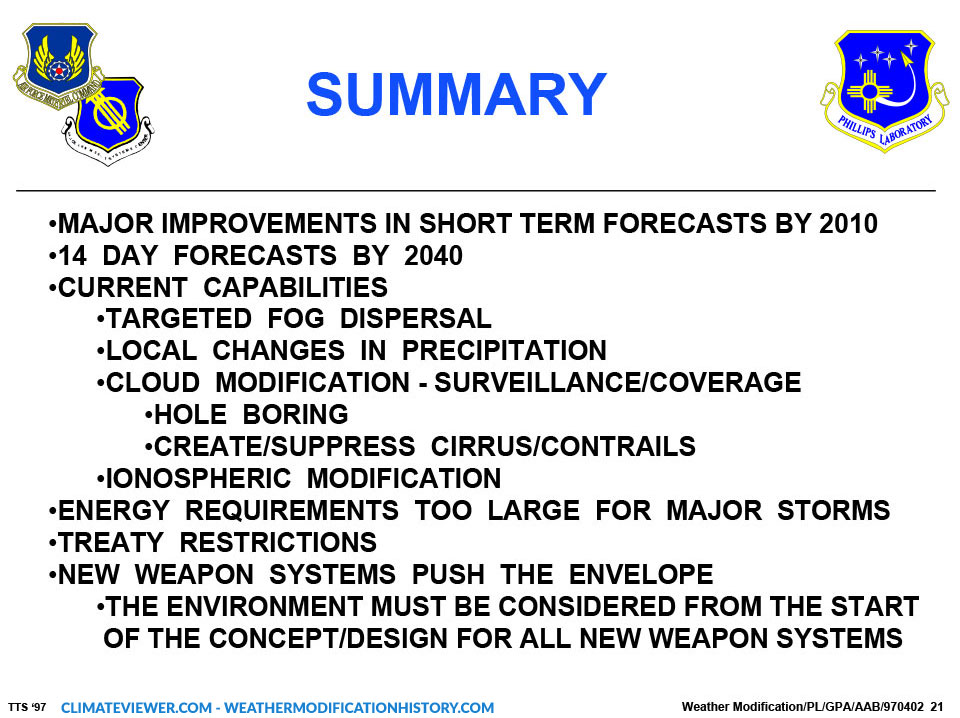
SUMMARY
- MAJOR IMPROVEMENTS IN SHORT TERM FORECASTS BY 2010
- 14 DAY FORECASTS BY 2040
- CURRENT CAPABILITIES
1. TARGETED FOG DISPERSAL
2. LOCAL CHANGES IN PRECIPITATION
3. CLOUD MODIFICATION - SURVEILLANCE/COVERAGE
- HOLE BORING
- CREATE/SUPPRESS CIRRUS/CONTRAILS
4. IONOSPHERIC MODIFICATION - ENERGY REQUIREMENTS TOO LARGE FOR MAJOR STORMS
- TREATY RESTRICTIONS
- NEW WEAPON SYSTEMS PUSH THE ENVELOPE
THE ENVIRONMENT MUST BE CONSIDERED FROM THE START OF THE CONCEPT/DESIGN FOR ALL NEW WEAPON SYSTEMS
— END OF DOCUMENT —


